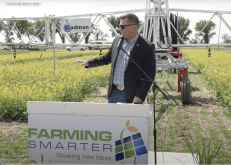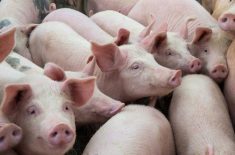With many veteran researchers reaching retirement age and research budgets being slashed, regaining lost capacity for long-term forage research will be an uphill battle, said the chair of a national forage association.
“To have somebody commit to long-term funding when most of the funding is based on a two- or three-year window is a real challenge,” said Doug Wray, chair of the Canadian Forage and Grassland Association.
“There’s a lot of work to do to convince them that’s a good place to put money when money is short.”
Read Also

Farming Smarter receives financial boost from Alberta government for potato research
Farming Smarter near Lethbridge got a boost to its research equipment, thanks to the Alberta government’s increase in funding for research associations.
And private industry isn’t stepping in to beef up forage research, said Alan Hall, project co-ordinator for the Alberta Crop Industry Development Fund (ACIDF), a Lacombe-based private funding agency.
“When you get over into the annual cropping world, you’re seeing a lot of private agronomists, corporate investments, new products, and new technologies,” said Hall. “That’s not happening to the same degree on the forage side of things.
“There’s not a real well-developed corporate presence in terms of development of forages, outside of the seed business.”
The longevity of forages makes them “less interesting” for the private sector, said Albert Kuipers, manager of the Grey Wooded Forage Association.
- More from the Alberta Farmer Express: Experts decry lack of long-term forage research
“The market for forage seed is small compared to annual production,” he said. “It’s difficult to get private-industry money into the forage sector, simply because the profitability isn’t quite as lucrative as it is for cereals and corn and canola.”
The forage industry is starting to see some five-year commitments for private research into forages, particularly corn silage, but farmers also need long-term, integrated research in other areas, said federal research scientist Vern Baron.
“For those crops that are of interest to agribusiness, there is quite a lot of research,” he said.
“It’s the other things that don’t have quite so much commercial interest but are useful on the farm that are difficult to deal with in terms of funding.”
That’s going to be the main challenge in increasing forage research, said Hall.
“Oftentimes, we’re accustomed to research giving us a quick fix, and there always seems to be good support for quick fixes,” he said. “Some of the longer-term work doesn’t get the same attention.”
The industry has recognized that there’s a funding gap for forage research and has begun funnelling more money into it, “but it’s an expensive, long-term proposition, and our capacity to do it is dramatically reduced,” said Wray.
That lack in capacity has more to do with manpower than money.
“ACIDF primarily funds the research and development world, and there’s really a lack of research and development science capability in forages,” said Hall.
“You go into the Ag Canada stations, into the universities, into the private sector, there just isn’t much in terms of forage scientists. And if you don’t have the scientists there, you usually don’t get the projects.”
Funding for “quality projects” is available through ACIDF and the Alberta Livestock and Meat Agency, but again, a shortage of researchers looms large.
“There’s a bit of capacity on the Prairies, but not anywhere near what’s needed given what we’re seeing coming forward as the challenges,” Hall said. “There’s going to have to be beefing up on the personnel side. Otherwise, it’s going to be a long road.”
A study commissioned by the Western Grains Research Foundation that will be released next year shows some of those “capacity limitations” in Western Canada.
“As we have retirements or get close to retirements, those scientists aren’t able to take on new kinds of research,” said Garth Patterson, the foundation’s executive director. “Unless we get that capacity replaced, we are going to run short of that core capacity to do long-term research.”
Baron agrees.
“There has to be enough capacity — places to do the work — and there has to be people to do the work. The smaller things get, the harder it is to do the kind of effective work that you need.”
Without increased research capacity, the forage sector won’t be the only area that suffers, he said.
“What you have is a risk that some aspects of agriculture will move ahead quite quickly, while other aspects will remain pretty much status quo for a long period of time,” said Baron.
“That’s not a very good competitive situation for those industries that depend on forages, like the beef and dairy industries.”














